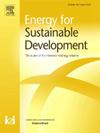Accelerating the penetration of clean electricity to promote the low carbonization of high-speed railways: A probabilistic framework
IF 4.4
2区 工程技术
Q2 ENERGY & FUELS
引用次数: 0
Abstract
Transitioning from carbon-intensive travel modes to high-speed railways (HSR) is widely recognized as a crucial pathway to achieving the ‘carbon peak and carbon neutrality’ goals in the transport sector. However, it remains unclear whether HSR can meet carbon peak goals on time, under the high uncertainty of future electricity development. This study integrates scenario analysis and Monte Carlo simulation into life cycle assessment, proposing a probabilistic framework for dynamically simulating the carbon dioxide (CO2) emissions over the entire life cycle of HSR. Monte Carlo simulation-Latin hypercube sampling method is introduced to model the uncertainty in the development of electricity. The results show that with the gradual increase in the proportion of clean electricity, the time when the CO2 emission intensity of HSR is lower than that of electric cars and electric coaches is most probable to occur in the 2nd–3rd years and the 5th–14th years of operation, respectively. The emission trend of HSR is primarily influenced by the passenger growth rate and the depth of transition to clean electricity, with minimal impact from the loading factor and initial passenger volume. When the passenger growth rate reaches 5 % by 2030, transitioning solely to clean electricity can peak CO2 emissions from HSR by 2030. However, with passenger growth rates of 6 %, 7 %, 8 %, and 9 %, the peak time is most probable to be delayed by 6–7 years, 13–14 years, 16 years, and 19 years, respectively. These findings suggest that achieving CO2 emission peak goals in the transport system requires collaborative efforts across multiple sectors, including transport, energy, and industry sectors. The results contribute to a deeper understanding of the pathways for achieving carbon peak in the transport sector.
加快清洁电力的普及,促进高速铁路的低碳化:概率框架
人们普遍认为,从碳密集型出行方式向高速铁路(HSR)过渡是实现交通领域 "碳峰值和碳中和 "目标的重要途径。然而,在未来电力发展具有高度不确定性的情况下,高铁能否按时实现碳峰值目标仍是未知数。本研究将情景分析和蒙特卡罗模拟整合到生命周期评估中,提出了动态模拟高铁全生命周期二氧化碳(CO2)排放的概率框架。引入蒙特卡罗模拟-拉丁超立方体抽样方法,对电力发展中的不确定性进行建模。结果表明,随着清洁电力比例的逐步提高,高铁二氧化碳排放强度低于电动汽车和电动客车的时间最有可能分别出现在运营后的第 2-3 年和第 5-14 年。高铁的排放趋势主要受乘客增长率和向清洁电力过渡的深度影响,受载客系数和初始乘客量的影响很小。当乘客增长率在 2030 年达到 5%时,仅过渡到清洁电力可使高铁的二氧化碳排放量在 2030 年达到峰值。然而,当乘客增长率分别为 6%、7%、8% 和 9%时,达到峰值的时间极有可能分别推迟 6-7 年、13-14 年、16 年和 19 年。这些研究结果表明,在交通系统中实现二氧化碳排放峰值目标需要多个部门的共同努力,包括交通、能源和工业部门。这些结果有助于加深对交通部门实现碳排放峰值途径的理解。
本文章由计算机程序翻译,如有差异,请以英文原文为准。
求助全文
约1分钟内获得全文
求助全文
来源期刊

Energy for Sustainable Development
ENERGY & FUELS-ENERGY & FUELS
CiteScore
8.10
自引率
9.10%
发文量
187
审稿时长
6-12 weeks
期刊介绍:
Published on behalf of the International Energy Initiative, Energy for Sustainable Development is the journal for decision makers, managers, consultants, policy makers, planners and researchers in both government and non-government organizations. It publishes original research and reviews about energy in developing countries, sustainable development, energy resources, technologies, policies and interactions.
 求助内容:
求助内容: 应助结果提醒方式:
应助结果提醒方式:


